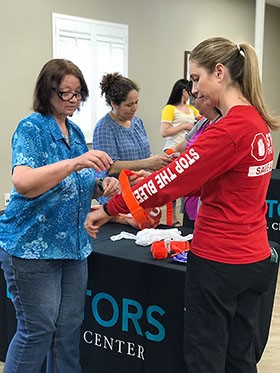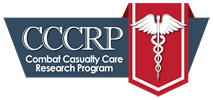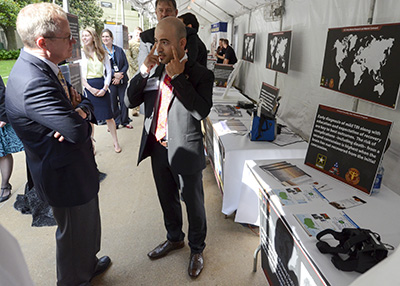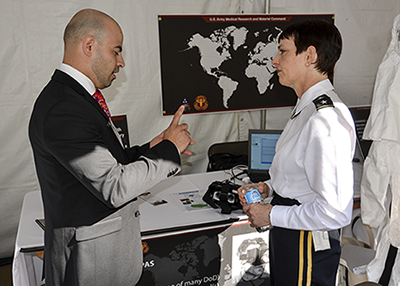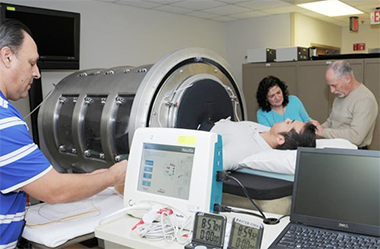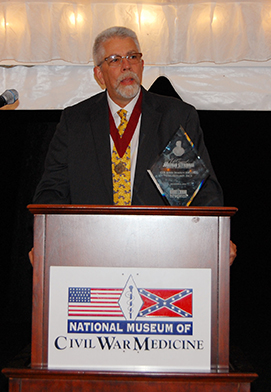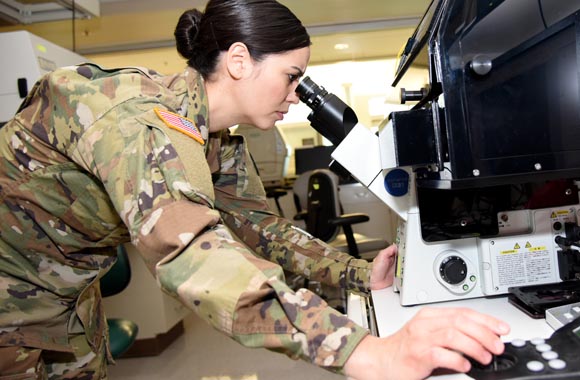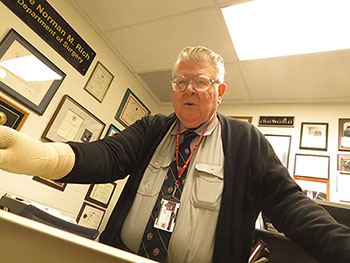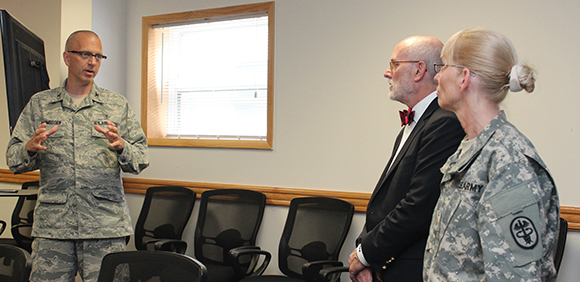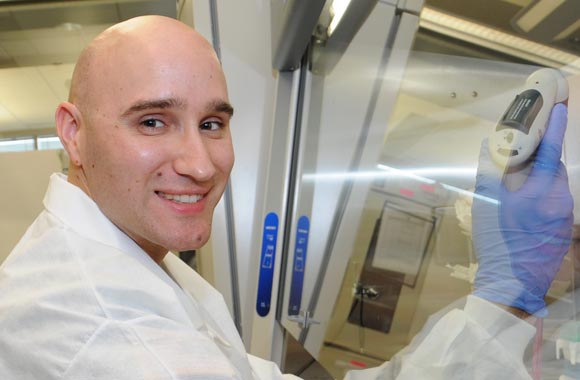- Home
- Press
- Monthly Scientist Highlights
Monthly Scientist Highlights
Spotlight on Tourniquets, Awareness Make "National Stop the Bleed Day" a Winner
6/11/2018
By Ramin A. Khalili, USAMRMC Combat Casualty Care Research Program Knowledge Manager
Wrapping up her final bleeding-control awareness class of the day at the University of Michigan Trauma Burn Center, Karla Klas made a startling realization.
"I always do a pre-class survey," said Klas, a registered nurse and the hospital's Managing Director of Injury Prevention and Community Outreach, "and the results showed that a full fifty percent of the people in today's classes know someone who's suffered from uncontrolled bleeding."
Klas' findings are just a small part of the overall awareness generated by the first-ever "National Stop the Bleed Day" event held on March 31 to boost the American public's understanding of the proper way to treat victims of traumatic bleeding. Accumulated stories and pictures from the event, which was organized in part by the Defense's Health Agency's own "Stop the Bleed" campaign -and which took place at several dozen locations across the country- are now flooding "Stop the Bleed" campaign administrators in the wake of National Trauma Awareness Month, which is held in May of each year.
"The plan was always to make a difference in people's lives," said Andrew Fisher, who -aside from being a physician assistant with the U.S. Army and a current medical student at Texas A&M University in College Station, Texas- was the main organizer of the event. "This is just the first step."
Early estimates show the campaign's more than 260 licensed partners trained more than two thousand people across the globe in the fundamentals of traumatic bleeding awareness as part of the event. The campaign itself was launched in 2015 via Presidential Proclamation as part of a plan to stem the effects of what is, according to federal data, the number one cause of death of all Americans from ages one to 46 years old.
"With the right skillset and a little awareness, traumatic bleeding in any setting can be stopped and lives can be saved," said Col. Michael Davis, campaign administrator and Director of the United States Army Medical Research and Materiel Command's Combat Casualty Care Research Program.
"Spreading these campaign tenets to interested citizens was one of the more rewarding experiences of my life," said Janssens Ronny, an emergency nurse and "Stop the Bleed" partner in Belgium who trained more than a dozen people himself during the day-long event.
Back in Michigan, sifting through the last few slides, handouts, and sign-up sheets of the day, Klas gave a more succinct, yet equally powerful, review of the event.
"This whole thing was just a major success," she said.
Lawmakers, Police Highlight "Stop the Bleed" During Roundtable on Mass Casualties
1/29/2018
By Ramin A. Khalili, USAMRMC Combat Casualty Care Research Program Knowledge Manager
Standing before a select group of lawmakers and medical professionals during a discussion on recent mass shootings across the U.S., Dallas Police Department Lt. Alex Eastman made a simple plea.
"We need a pathway forward," said Eastman, himself both a trauma surgeon and a member of the department's SWAT team. "We need a better model."
Eastman's words set the tone for the first-ever "Active Shooter Listening Session" event, held on January 17 at the Department of Homeland Security in Washington, D.C. Given the slew of recent mass casualty events across the country, organizers sought to bring together a wide variety of federal agencies and local organizations -including the FBI, FEMA, and representatives from a slew of major universities- in order to both learn from prior incidents and to brainstorm a plan to save lives during possible attacks in the future.
"When crisis happens, you have to think fast," said Kathleen Fox, Acting Deputy Administrator of Protection and National Preparedness at FEMA and also a speaker during the event. "And so we can learn a lot from each other and these experiences."
The concept of preparedness was a key component of the detailed presentations delivered by both the Las Vegas (Nev.) Metropolitan Police Department and the Rancho Cucamonga (Calif.) Fire Department, each of whom have responded to their own respective active shooter events in recent years. Both agencies pointed to the "Stop the Bleed" campaign -a bleeding-control awareness effort developed by the U.S. Army Medical Research and Materiel Command's Combat Casualty Care Research Program- as the blueprint for teaching community members how to aid each other in situations of mass trauma.
"Since October first of 2017, you can't believe how many people want this training," said Sergeant Branden Clarkson of the Las Vegas Metropolitan Police Department, referring to last year's mass shooting on the Las Vegas Strip in which more than 50 people were killed.
Among the dozens more people injured in that same shooting was Clarkson's own twin brother, who is also a police officer and who was providing security along the Strip at the time. Clarkson's brother was shot in the neck during the rampage but managed to survive by driving himself -and several other injured people- to a local hospital for treatment.
"Community response was absolutely key for us that night," said Clarkson.
According to Clarkson, attendance at local traumatic bleeding control classes has skyrocketed since the shooting, and Eastman reports his department has trained more than one million citizens in proper bleeding control techniques in the greater Dallas area alone since the "Stop the Bleed" campaign launched in late 2015. Numbers like those show that concepts like awareness and preparation are on the minds of both the public and the country's first responders - all of which could indeed lead to a better way forward in a complex and uncertain world.
"Saving lives is always number one," said Eastman. "Everything else revolves around that."
Multiple Choices, Multiple Answers as TBI Enters the Battlefield of the Future
10/6/2017
By Ramin A. Khalili, Knowledge Manager, USAMRMC Combat Casualty Care Research Program
"We're just trying to address as many military needs as possible," said Drexel University professor Dr. Baruch Ben Dor during his Breakout Session presentation on cutting-edge TBI-detection technologies at a recent military health conference in Kissimmee, Florida.
Developed through a multi-university partnership agreement, Ben Dor's Infrascanner device uses near infrared spectroscopy technology to locate pockets of intracranial pressure that may, in turn, indicate a potential TBI. By applying multiple sensors to the head, forehead, and limbs, the Infrascanner measures the absorbance of light at four separate areas of the brain, the results of which are then interpreted by a clinician. This type of technology, while previously used to measure more run-of-the-mill physiologies like local tissue oxygenation and heart rate viability, may now serve an important role during en-route care and evacuation scenarios in future battlefield situations.
"This is something like ultrasound was 40 years ago," said Ben Dor. "And so we're excited to take that existing technology and then mold it to whatever is needed in the field."
When it comes to the world of TBI, that willingness to "upcycle" previous ideas and applications is now en vogue, as investigators try to not only establish biomarkers for the diagnosis of TBI severity, but also try to develop non-invasive neurological assessment devices for all strains of TBI. For researchers across the entire discipline, the buzzword is "fusion."
"While we'd love to have just one device for all our needs, the reality is that we're taking more of a ‘Frankenstein's monster' approach to head injury detection and diagnosis," said Dr. Tammy Crowder, manager of the U.S. Army Medical Research and Materiel Command's Neurotrauma and Traumatic Brain Injury portfolio.
Said Crowder, "We're excited about all the products here, but in many ways they're all just one part of the larger whole."
Given that more 360,000 service members worldwide have suffered a TBI since 2000, questions about the cause, scope, and impact of TBI far outnumber current solutions. In addition, products currently being developed to aid TBI diagnosis are further complicated by the recent Army-wide focus on prolonged field care, which dictates attention to the concepts of miniaturization and portability in addition to reliability.
"Right now we're working on imaging the entire head," said investigator Dr. Jason Riley, referring to the infrared transcranial hematoma imaging device he developed with his private-sector partners. "And even better we've got the whole thing down to the size of a briefcase, which a big plus to operators in the field."
While always a high-profile capability gap for the Army, the process of developing diagnosis solutions for TBI and TBI risk factors now stands at a crossroads where the need for immediate solutions collides with a parallel need for compact integrity. For both Ben Dor, whose device is the size of a supermarket scanner, and Riley, whose device is currently engaged in clinical trials, their respective efforts put them at the very leading edge of TBI research.
Said Crowder, "It's truly exciting to watch all these efforts take place right here, right in front of you."
Visionary Medical, Tactical Tools Take Center Stage at Pentagon
6/1/2017
By Ramin A. Khalili, USAMRMC Combat Casualty Care Research Program Knowledge Manager
After spending an hour in the midday sun setting up a neurotrauma-themed display booth at the Pentagon, Dr. Marcello Pilia stepped back, wiped the sweat from his forehead, and admired his work.
"This is the main attraction right here," said Pilia, Deputy Manager of the Neurotrauma Portfolio for the U.S. Army Medical Research and Materiel Command's Combat Casualty Care Research Program, pointing to the neuro-diagnostic I-Portal PAS tool funded in part by the CCCRP. "Let's just hope it gets the attention it deserves."
Jockeying for attention was indeed part of the gamesmanship during the bi-annual DoD Lab Day event, which took place from May 17-18 in the center courtyard of the Pentagon in Arlington, Va. Designed to showcase cutting-edge knowledge and materiel products from the Army, Navy, and Air Force, the event routinely features hundreds of enlisted personnel, contractors, and government employees, and further serves as a chance for high-level DoD administrators to both assess the progress of current funding efforts and to identify upcoming capability gaps.
"You spend so much time focused on your own products that it's nice to get out here and see what everyone else has been up to," said Dr. Anne Ritter, Assistant Manager for the CCCRP's Forward Surgical-En Route Care Portfolio, who attended the event to present the latest iteration of the Compensatory Reserve Index tool, a palm-sized device designed to assist clinicians in quickly identifying severely injured warfighters on the battlefield.
Other advancements presented by the U.S. Army Medical Command during the two-day event included the REBOA, which is a balloon-tipped catheter use to stem severe bleeding in trauma patients; and the I-Portal PAS, a device that uses virtual-reality technology to assess possible brain injuries by measuring a series of oculo-motor pathways.
"The entire event is really an opportunity to showcase what we do on a daily basis, and then to bring that hard work to a larger audience," said Major General Barbara Holcomb, USAMRMC Commanding General, who toured all 90 display booths during a VIP visit on the morning of May 18.
Said Pilia, "The size and scope of the whole event, the advancements being made on a daily basis, it's really an amazing thing to be a part of."
Photo Credit: Adam Wyatt/TATRC
Center Created to Improve Outcomes of Combat Casualties
2/1/2017
By Dr. Steven Galvan, USAISR Public Affairs
The U.S. Army Institute of Surgical Research at Fort Sam Houston, Texas, has a new research center focused on improving outcomes from the leading cause of death on the battlefield. The Battlefield Health and Trauma Center for Human Integrative Physiology, or BHTCHIP, was formed by the USAISR senior scientist to study inadequate tissue oxygenation associated with military trauma and battlefield health that will result in new knowledge and materiel solutions for accurate and timely assessment of Warfighters suffering from hemorrhagic shock or compromised performance.
"The focus will be on developing advanced clinical assessment and intervention for improved outcomes of combat casualties suffering from hemorrhage and healthy Soldiers whose performance may be compromised by battlefield conditions," said Dr. Victor "Vic" Convertino, senior scientist for the U.S. Army Medical Research and Materiel Command's Combat Casualty Care Research Program. "The BHTCHIP includes the only research laboratory in the Department of Defense with the unique capability that allows for the study of the physiology of human hemorrhage and onset of hemorrhagic shock using the model of lower body negative pressure."
The lower body negative pressure chamber consists of an airtight chamber that creates a vacuum below the waist of test subjects to simulate the reduction in blood volume in the upper body, similar to that experienced with hemorrhage.
"The LBNP simulates a person progressively 'bleeding out' without removing a single drop of blood from them," explained Convertino.
The LBNP model used by the BHTCHIP is unique in that it has been used to collect physiological data from more than 270 volunteers exposed to simulated hemorrhage that leads to hemodynamic decompensation (early stage of shock). According to Convertino, the database has proven uniquely critical in the development of the only state-of-the-art capability in the world that will allow emergency medical caregivers the ability to assess the status of bleeding patients, such as combat Wounded Warriors, or assist unit commanders to recognize compromised Soldier performance.
That state-of-the-art technology is designed to measure the body's compensatory reserve, the body's ability to compensate for low-volume blood loss with minimal change in traditional vital signs, using an algorithm called the Compensatory Reserve Index that utilizes the information from the arterial wave of a standard pulse oximeter. The CRI monitor gauges whether a patient or Soldier engaged in combat requires resuscitation or immediate medical attention due to a compromise in tissue oxygenation during low circulating blood volume states.
"The CRI is a non-invasive medical device that can evaluate information from waveforms," said Convertino. "The algorithm provides a decision support system that could help battlefield care providers make earlier life-saving decisions or to assist unit commanders in recognizing when a Soldier's performance is compromised, which could potentially affect the unit's mission."
Convertino's vision of the BHTCHIP is to continue to develop new clinical research protocols designed to provide experimental and clinical validation of the compensatory reserve as a measurement of tissue oxygenation.
"We have already developed new studies and the experiments are ongoing," he said. "The preliminary results indicate that measurement of the compensatory reserve provides superior sensitivity and specificity for low circulating blood volume states than standard vital signs."
Researchers Go Back in Time for Whole Blood Solution
11/9/2016
By Ramin A. Khalili, USAMRMC Combat Casualty Care Research Program Knowledge Manager
"You add up the years and you learn a few things," said retired Army Col. John Holcomb during a presentation on blood products at Fort Detrick on October 6. "But most of all you learn that minutes really do count."
For Holcomb, all those minutes spent fighting and fixing traumatic injury add up to more than three decade's worth of contributions as a soldier, a surgeon, and a scientist. Following multiple service deployments and a stint as the head of the Army Institute of Surgical Research in San Antonio, Texas, Holcomb took a position at The University of Texas Medical School at Houston, where his adaptation of combat skills to a contemporary domestic setting have yielded a number of positive benefits.
"We've been able to reduce the number of trauma deaths at our hospital by 30 percent just by applying the skills I learned in the military," said Holcomb, in town to receive the Major Jonathan Letterman Medical Excellence Award as judged by the National Museum of Civil War Medicine. "Things like using tourniquets and using whole blood - none of that crystalloid or clear liquid."
The latter may be Holcomb's most important contribution to civilian resiliency. During his presentation to assorted MRMC staff members, he was quick to explain how whole blood -which up until recently had been the gold standard for battlefield resuscitation- was once again becoming the top choice for trauma surgeons.
"We made a big mistake in the 1970s by relying too much on crystalloids and components and things that cause side effects like edema," said Holcomb. "By returning to whole blood, we're back on the right track."
Said CCCRP Director Col. Todd Rasmussen, who attended the presentation with his staff, "This is the kind of important information we need to consider as we try to change the impact of trauma on the American public."
Given that trauma is the number three overall cause of death in the U.S., and that it further accounts for more than $580 billion in health care costs annually, that kind of "back to the future" approach could be the key to saving lives across the country. "Whole blood has a higher value to the patient, a higher efficacy to us, and decreased cost overall," said Holcomb. "Let's get ahead of this."
USAISR Researchers Looking for Eye Injury Treatment
8/1/2016
By Steven Galvan, USAISR Public Affairs Officer
Researchers at the U.S. Army Institute of Surgical Research are looking for a novel way to treat eye injuries that can result in blindness. According to USAISR researchers, a non-invasive treatment could be available to Wounded Warriors with eye injuries within the next two to three years.
"We are currently investigating proliferative vitreoretinopathy or PVR, a potentially blinding disorder that can result following a tear or detachment of the retina," said Capt. Elaine Por, a principle investigator and deputy task area manager in the Ocular Trauma Division at the USAISR.
Por stated that following a retinal tear or injury approximately 5 to 10 percent of the U.S. population develops PVR; however the occurrence of PVR is significantly higher in Warfighters who sustain an ocular injury on the battlefield. Currently, the standard treatment of care for PVR involves surgery to the retina or posterior segment of the eye.
"Unfortunately, the success rate for repairing a retinal tear or detachment through surgery is not great," said Por. "It is an invasive treatment option that often leads to recurrent detachment of the retina and subsequently the need for additional surgeries."
To search for a non-invasive treatment for PVR, researchers are actively working with induced pluripotent stem cells, which have been differentiated into retinal pigmented epithelial cells. Extensive literature suggests RPE cell activation as a major contributor to the pathology of PVR. Following a significant injury to the eye or head, a retinal tear can lead to the activation of RPE cells.
"When RPE cells become activated they demonstrate abnormal increases in cell migration, proliferation and contraction," Por said. "These processes altogether are thought to be involved in the development and progression of PVR."
Por has a recently accepted manuscript, scheduled to be released later this year in the Journal of Ocular Pharmacology and Therapeutics, which details her research and the data gathered thus far. She added that the laboratory research involves testing different drugs or compounds that can block the activation of RPE cells.
"I really love this project because we are attempting to find a promising therapeutic to treat a problem that is prevalent among our Wounded Warriors," said Por. "Our in vitro, or cell-based research, is providing us with some promising data, but we are continuing to test different compounds and techniques to identify a therapeutic(s) for PVR that can be translated to the clinic."
Vietnam-Era Research Hits Milestone, Tapped for Preservation
6/1/2016
By Ramin A. Khalili, USAMRMC Combat Casualty Care Research Program Knowledge Manager
Standing over a small metal bookshelf in his office at the Uniformed Services University of the Health Sciences in Silver Spring, Maryland, Dr. Norman Rich rifled through a stack of medical documents like a man flipping through an old college yearbook.
"Every last bit of this stuff is going to the National Archives," he said with a grin. "Almost 8,000 records in all."
The comparison is fitting, as for Dr. Rich -a Vietnam War veteran and the current Leonard Heaton and David Packard Professor of Surgery at USUHS- his records represent, quite literally, his entire life's work. After serving as the creator and main steward of the Vietnam Vascular Registry for five decades, he was told in February that the VVR had been selected for inclusion into the U.S. National Archives and Records Administration Database in St. Louis.
"I almost fell out of my chair," said Rich, recounting his congratulatory call with Department of Defense officials earlier this year. "In over 50 years in the federal system, I don't think I've ever received such a positive phone call from anyone—ever."
The VVR is essentially a highly-detailed record of blood vessel injuries sustained by American Service Members during the Vietnam War, as well as notation on all respective follow-up treatments performed over the past half century. In all, Rich estimated his files, which up until a few years ago were stored in plain brown boxes on the floor of his office-, include more than 600 Service Members. Overall, he's spent more than 30,000 man hours collecting, reviewing and filing the data."Hopefully the results at 50 years will help those future clinicians predict, at least a little bit, their outcomes for their current casualties," said Rich, stating his hope that the VVR might ultimately provide a blueprint for succeeding generations of military surgeons.
Such an impact has clearly already been felt, however.
"The work he's done as both a surgeon in helping injured Warfighters and as a researcher in collecting reams upon reams of key data are both equally astounding and impressive," said Col. Todd Rasmussen, director of the U.S. Army Medical Research and Materiel Command's Combat Casualty Care Research Program, in regards to Rich's legendary medical status and sustained research efforts.
Shuffling through the one last stack of pictures, news articles and medical journals piled high on his old bookshelf, Rich closed down his filing work for the day by recounting a different kind of story - one involving a former patient, a Soldier in the Vietnam War who, upon noting the controversial nature of the conflict, made a request that has accompanied the VVR mission for 50 years.
"He told me 'make something good out of this mess,'" said Rich. "I'd like to think that we tried. I like to think that we did."
MRSN Team Awarded MHSRS Outstanding Research Award
3/1/2016
By: Ramin A. Khalili, Knowledge Manager, Combat Casualty Care Research Program & the WRAIR Public Affairs Team
For their sizable research efforts in developing the ARMoR program in support of wounded warfighters everywhere, congratulations are in order for Col. Emil Lesho and his MRSN team for receiving the 2015 Outstanding Research Accomplishment award at the 2015 Military Health System Research Symposium in Ft. Lauderdale, Florida.
The Multidrug Resistant Organism Repository and Surveillance Network has been influencing policy and procedure since its inception in 2009, beginning with the fatal outbreak of methicillin-resistant Staphylococcus aureus (MRSA) in the neonatal intensive care unit at the National Naval Medical Center. Feedback provided by the MRSN resulted in the current policy being changed from targeted to universal screening of neonatal intensive care unit admissions.
Most recently in 2015, the MRSN established the structure and architecture of the ARMoR-D database which is being used as a model for the CDC, the NCBI, and others, to develop a public database such as Genbank that links whole genome sequences to clinical, demographic, and antibiogram data. The award for the ARMoR program at MHSRS was presented to Col. Lesho during MHSRS by Rear Admiral Bruce A. Doll, DC, USN, Director, Research, Development and Acquisition, Defense Health Agency, and the Deputy Commander, US Army Medical Research and Materiel Command.
White House Taps Military Medicine Expertise for Emergency Preparedness Campaign
12/1/2015
By Steven Galvan, Public Affairs Officer, U.S. Army Institute of Surgical Research & Ramin A. Khalili, Knowledge Manager, Combat Casualty Care Research Program
The White House Administration alongside other government leadership announced a new national public service campaign Oct. 6, designed to boost public awareness of what each person can do to help save lives during a major disaster. The campaign, called "Stop the Bleed," is based on the success of the U.S. military in reducing combat deaths during recent conflicts in Afghanistan and Iraq. In those cases, since most combat fatalities occurred on the battlefield prior to reaching a hospital and the majority of potentially preventable deaths occurred due to hemorrhage, bleeding control is now a cornerstone of the improved survival techniques used by the Armed Forces. A person who is bleeding can die from blood loss within five minutes. The "Stop the Bleed" campaign aims to teach everyday citizens basic techniques in hemorrhage control so that an injured person has a greater chance of living long enough to reach a doctor's care at the hospital.
"The DOD's clinical experience and research in these areas underpins this entire effort," said Col. Todd Rasmussen, director of the U.S. Army Medical Research and Materiel Command's Combat Casualty Care Research Program, during his remarks at the campaign launch.
The CCCRP played an integral role in the development of the campaign, creating the "Stop the Bleed" logo and official campaign slogan, as well as advising DOD and the National Security Council on program content. The American College of Surgeons has also joined the campaign, establishing the Hartford Consensus Group that has championed the translation of military advances in external hemorrhage control to bystanders, law enforcement, firefighters, and emergency medical service medics.
"The efforts of this group have been compiled into the Hartford Consensus Group compendium that was recently released as a special communication of the college in an effort to improve survival from these events - which are, unfortunately, becoming increasingly common in the United States," said Chairman of the Committee on Tactical Combat Casualty Care Dr. Frank Butler, who is also the director of prehospital trauma care at the U.S. Army Institute of Surgical Research Joint Trauma System.
As a special operations surgeon while on active duty, Butler learned firsthand that someone with severe bleeding can bleed to death in a matter of minutes—often before the arrival of a trained medic. He has also seen the dramatic increases in survival achieved by the 75th Ranger Regiment and other special operations units that adopted the use of tourniquets and hemostatic dressings. "Thanks largely to the efforts of the Tactical Combat Casualty Care group that have been ongoing since 1993, all of the U.S. military is now trained to provide life-saving external hemorrhage control interventions," Butler said. Butler added that these advances in combat trauma care have saved many lives on the battlefield, and now this knowledge will do the same thing in the civilian sector. Learn more about how to "Stop the Bleed" and help save a life by accessing training and resources: http://www.dhs.gov/stopthebleed (NOTE: This link will take you out of the CCCRP web site.)
Army, DOD Experts Discuss Multi-pronged Approach to Brain Injuries
11/1/2015
By Ramin A. Khalili, USAMRMC Combat Casualty Care Research Program Knowledge Manager
Standing before a select crowd at Fort Detrick, Maj. Pamela DiPatrizio spoke in blunt terms about the DoD's current assessment of traumatic brain injury.
"You don't just suck it up and drive on anymore," she said, "especially with a TBI."
DiPatrizio, the Chief Education Outreach Officer with the Defense and Veterans Brain Injury Center, appeared at Fort Detrick Aug. 7 as part of a seminar designed to share updated research and care protocols with staff from the U.S. Army Medical Research and Materiel Command's Combat Casualty Care Research Program.
"We organized this event, quite simply, to get everybody on the same page about TBI," said Dr. Tamara Crowder, Neurotrauma and Traumatic Brain Injury portfolio manager for the CCCRP and chief organizer of the event.
According to DiPatrizio, more than 80 percent of all worldwide DoD TBI cases are diagnosed as mild, while less than two percent of all cases are diagnosed as severe.
"When you're talking about penetrating or severe TBI, you're not talking about all that many," said Dr. Donald Marion, Senior Clinical Consultant with DVBIC, who presented alongside DiPatrizio. "But with more than 325,000 total cases since 2000, you're still talking about a substantial amount."
While research continues in addressing the long term effects of severe and penetrating TBI, both DiPatrizio and Marion agree that successful recovery from mild TBI rests on a multi-step approach of education, early detection, treatment, and rehabilitation.
Said DiPatrizio, "Rest and progressive return to activity is the 'new normal' when recovering from TBI."
BRDSS-C receives 510(k) clearance from FDA
7/12/2015
By Steven Galvan, Public Affairs Officer U.S. Army Institute of Surgical Research 12 JULY 2015
"This is the first time that the ISR has been able to take a medical device from a blackboard concept to a full Food and Drug Administration (FDA) 510(k) clearance using our newly developed internal quality system," said Jose Salinas, the Comprehensive Intensive Care Research, Single/Multiple Organ Support, and Vital Tissue Preservation Task Area manager at the U.S. Army Institute of Surgical Research (USAISR) at Joint Base San Antonio-Fort Sam Houston, Texas. "This marks the beginning of a new model for medical device development within an Army research institute."
Salinas is talking about the Burn Resuscitation Decision Support System-Clinical (BRDSS-C) that was developed for use by burn personnel to manage and optimize fluid resuscitation of severely burned patients admitted to the USAISR Burn Center. According to Salinas, "The entire development was handled internally through ISR processes. We were able to conceptualize, test and provide all the necessary data to the FDA for clearance of the system without the need for an external medical device company serving as our sponsor.
"We first discussed the concept of computer-based decision support systems for burn resuscitation at the ISR in 2005. We wanted to explore the possibility of developing an algorithm that would assist providers to improve fluid management in severely burned patients that could also potentially improve their outcomes," said Salinas.
A related technology from the ISR (BRDSS-Mobile/Burn Navigator) received the same clearance in 2013, "but the process was handled by Arcos Medical, Inc. of Houston through a collaborative agreement with the USAISR. This process involved granting a technology license to Arcos to commercialize the technology and also get the FDA 510(k) clearance with ongoing collaboration and assistance from the ISR," said Maria Serio-Melvin, Program Director for Information and Computer Decision Support Systems and FDA Program Manager for Decision Support Software Medical Devices for Salinas' task area.
The clinical and mobile algorithms are designed to assist care providers in avoiding problems related to over- or under-resuscitating burn patients, a potentially fatal issue. However, the BRDSS-C has been designed and implemented for use by experienced burn providers and includes recommendations and rules tailored for burn experts. The Burn Navigator, on the other hand, was designed for field deployment and use by non-expert users with little or no burn care resuscitation expertise.
"Because this system is designed to assist care providers with decisions it will also help relieve anxiety, stress, and validate decisions while taking care of severely burned patients," Serio-Melvin said.
The eventual goal is to have both systems working together seamlessly. Right now, a Burn Navigator used in a deployed setting can be transferred with a patient through the different care settings in a warzone. In the future, we are hoping that once a patient arrives at the Burn Center for definitive care, the data from the Burn Navigator will be imported into the BRDSS-C for uninterrupted care.
"And now we have two products to assist with resuscitation of burn patients," said Salinas.
Salinas added that while the Burn Navigator is designed for battlefield use, multiple Burn Navigators could also be used stateside during a mass casualty scenario to treat numerous burn patients.
"It would be helpful for the care provider because all of the fluid resuscitation data would be readily available on the Burn Navigator for each patient," he said.
Although both systems are working as designed, Salinas said that he and his team are looking forward.
"We want to push the envelope and design a system that will automatically resuscitate a burn patient without human intervention in some cases," Salinas said. "The ISR is on the forefront of technology and we've been asked by the FDA to work on this concept as part of a larger initiative on autonomous systems for the critical care environment."
"We wouldn't be here without the unwavering support of MRMC," said Serio-Melvin. "Now we have two products to assist with the resuscitation of burn patients."
The USAISR is a subordinate command of the U.S. Army Medical Research and Materiel Command at Fort Detrick, Md., the Army' major command that leads efforts in support of the full life cycle of medical supplies and equipment, to include research, development, acquisition and sustainment.
Winans Triumphant at MRMC's 'Best Warrior' Competition
5/13/2015
By Steven Galvan, Public Affairs Officer U.S. Army Institute of Surgical Research 27 MAY 2015
The 2014 U.S. Army Institute of Surgical Research (USAISR) Soldier of the Year competed at the 2015 U.S. Army Medical Research and Materiel Command (USAMRMC) Best Warrior competition at Fort Detrick, Md., and came out victorious in his category. Spc. Matthew D. Winans, a Bioscience Specialist at USAISR Dental and Trauma Research Detachment (DTRD) won the USAMRMC Best Warrior competition and will now compete at the 2015 Army Medical Command Best Warrior of the Year competition in May.
"It feels great to earn the title of MRMC's Best Warrior," said Winans. "It is a reflection of the outstanding leadership and training I received from the noncommissioned officers [NCO] at the ISR. The achievement was a team effort."
To prepare for the competition, Winans and Staff Sgt. Pablo Sierra, the 2014 USAISR NCO of the Year, who competed at the NCO level, trained and studied with the assistance of several ISR NCOs in the different categories of the event. Winans credits the countless hours of training and studying to be the deciding factor in the competition.
"Each competitor was physically and mentally strong," he said. "It was slightly stressful due to the pace of the events and the cold weather. Near the end of the competition, the small gaps between the competitors increased the anxiety for everyone. As the competition progressed, it was wonderful to see the esprit de corps between competitors."
Sierra who took the runner-up spot in the NCO of the Year competition will continue to train and study with Winans. "It was an exceptional performance by both ISR competitors," said Col. (Dr.) Michael D. Wirt, USAISR Commander. "Our two Soldiers truly embody the Warrior ethos and proudly represented the ISR throughout the competition."
USAISR Sgt. Maj. Quinton Rice Jr. said he was proud of both competitors and attributes Winans' success to the support and motivation from their departments and the entire organization.
"It was a very tough competition," said Rice. "It went down to the last event and Spc. Winans out distanced the top members of eight other organizations under the MRMC umbrellas."
Winans also attributes his success to the support of his wife and family, his sponsor Staff Sgt. Scott Eriksen, and the personal guidance he received from Sierra during the competition.
"Staff Sgt. Sierra kept saying 'you are never out of the fight,'" said the Wellsville, N.Y. native. "From that advice I was able to manifest personal courage and stay positive in the face of adversity."
Winans, who has been at DTRD for almost two years and in the Army since 2012, said that he will continue to train and study for the next competition.
"Spc. Winans is a stellar Soldier who has the initiative, drive and discipline to accomplish anything he wants," said Staff Sgt. James McAlister IV, DTRD NCOIC. "I am so proud that he was able to implement the training he received for this competition and I will continue to support him throughout the next one."
Rice believes that Winans will excel at the next level.
"I believe that if our organization continues to support him and provide him challenging training, then he will do exceptionally well," said Rice.
